19 Types of Paint Brushes Designed for Specific Tasks
Author: Omar Alonso | Editor: Omar Alonso
Review & Research: Jen Worst & Chris Miller
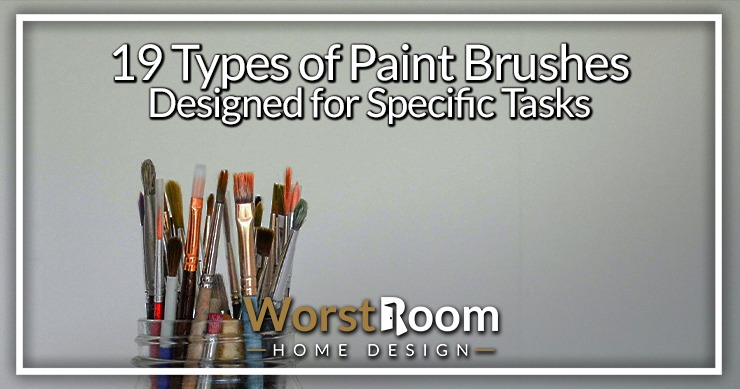
Where having different types of paint brushes come in handy is when you never know which project will need some work. After all, depending on the application, every brush has its own unique features that make them perfect for usage over different surfaces.
It’s kind of obvious that a single brush won’t be able to do everything you want on a canvas, a wall, furniture, or any other surface we're about to slather with paint.
But exactly how many are there you actually need to have in your collection? Well, that’s what you’re about to find out in a while. All you have to do is just scroll down.
19 Types of Paint Brushes
There are lots of paint brush types with big and small variations in style and usage. Let us get you introduced to all of them.
Filbert Brush
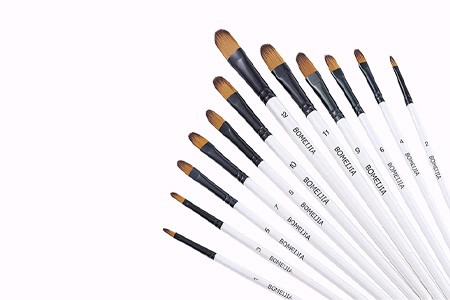
Filbert brush is considered to be one of the most commonly used brushes all over the globe, especially among painters. It has a chiseled edge with a rounded shape. As there are trimmed corners on the brush, the head takes a crescent shape.
The filbert brush gets its name from visually looking like a hazelnut from the filbert tree.
There are a wider variety of sizes in this type of brush. The most common sizes are 0, 2, 4, 6, 8, 10, and 12. The brush is considered ideal, especially for round strokes.
Besides, it’s used for washes as it can hold a sufficient amount of water. They’re also used for stroking and blending on paintings, including flowers, leaves, figures, etc.
Flat Brush
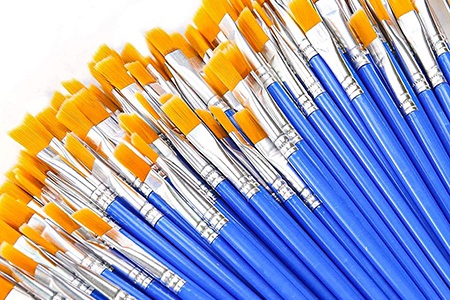
The flat brush is one of the most used brushes utilized mostly for painting larger areas. With a square shape on the head, it comes with medium to long hairs.
They work as a preferable choice where ease of maneuverability and manipulation is required for completing the artwork. Plus, they’re also used for drawing straight lines along with bold and vivid strokes.
They’ve got a wider variety compared to lots of the other brushes when it comes to size. They’re available in sizes like 0, 1, 2, 4, 6, 8, 10, 12, 14, 16, 18, 20, and 24 so you can collect different paint brushes to help you with each task.
Their application is significantly noticed in painting larger areas along with blending, especially in paintings of landscapes and mountains. There’s a chance of getting confused between wash brushes and flat brushes. But a major difference between the two is flat ones come with sharper bristles.
Rigger Brush
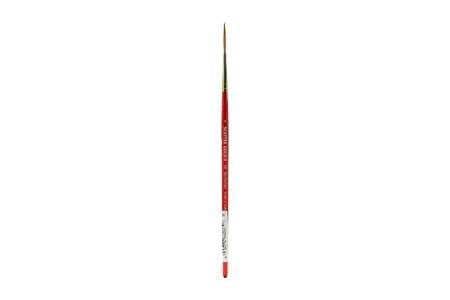
You can call it both rigger or liner brush. It comes with longer hair than most of the other brushes and is usually used in paintings requiring straight lines. The best colors for this brush are oil, watercolor, or acrylic types of paint.
This type of brush is mostly used for detailing and outlining. As it comes with a fine tip, the brush is also preferred by artists who work with lettering and calligraphy. Though the brush tip is very little, it holds a good amount of color.
Another common application of these types of paint brushes is seen among artists while they put their signature on a painting. When it comes to sizes, this brush is available in sizes that start at 0.5mm and end at 3mm.
Round Sash Brush
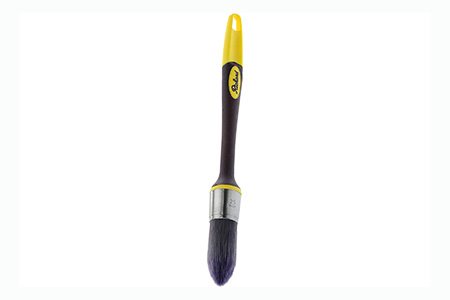
The round paintbrushes come with rounded handles and bristles. Due to the shape, the brush fits in like a regular pencil.
Another common feature of this type of brush is its slightly pointed tip. Compared to the angled or flat brushes, these brushes are smaller. Besides, the corners come with a rounded soft edge.
They’re mostly used for techniques where the artists need both thick and thin lines, fills, and washes for their painting. Plus, they’re used in paintings where the overall control has to be high.
As most round sash brushes are narrow, they’re used to create thinner lines, especially for details. Along with that, they’re preferred by painters for outlining a painting.
Round brushes are significantly high on the number when it comes to sizes. The available sizes of the brush are 0000, 000, 00, 0, 1, 2, 3, 4, 5, 6, 7, 8, 9, 10, 12, 14, 16, 18, 20, and 24.
Bright Brush
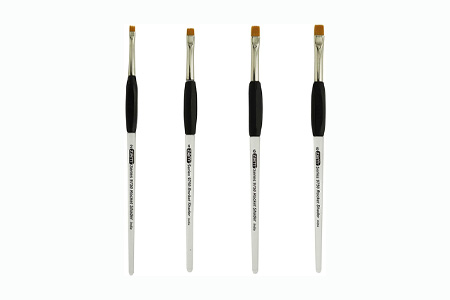
A bright brush is a brush with short, stiff hair and is used in paintings where maximum control is required. In the question of similarity, it usually matches flat brush. Actually, to a certain extent, it’s considered the alternative to flat brushes.
The bristles are curved and create a shape tapering towards its tip. But that doesn’t stop the brush from drawing straight lines and keeping the edges clean, just the way flat brushes do.
This brush is perfect for using thick paints over the painting. Plus, artists use it when they need to apply heavier colors to the paper. But artists seem to avoid using this brush when it comes to layering wet-in-wet. The brush comes in sizes like 0, 2, 4, 6, 8, 10, 12, 14, and 16.
Angled Brush
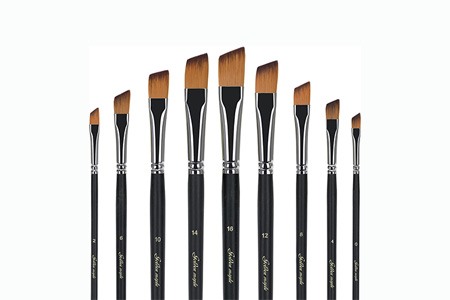
Angled brush is simply another variation of the regular flat brush. Due to its unique shape and angled bristles, it’s also known as the sword brush. It’s used for painting where precise strokes are a must.
Besides, it’s also seen in the application for paintings where the painter needs to color up tighter spots. Not only that, but this kind of brush is considered an essential tool for artists when it comes to curving.
We’ve noticed a similarity between Angled and Rigger types of paint brushes. What makes them different from each other is the tip of the Angled brush which is steeply angled compared to the liner. Probably this is why it has another name – the striper brush.
This brush can draw an extremely thinner line when the artist uses only the tip. It can also draw a fuller liner with an angled grip. If you’re looking for an angled brush to draw thinner lines, then there are different sizes like 0 to 16.
Fan Brush
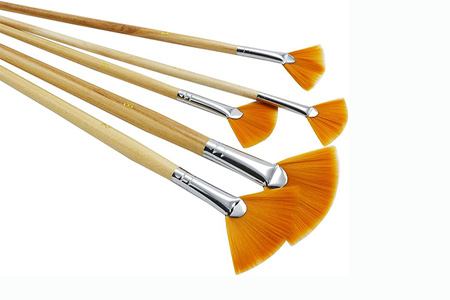
Like the name says, this one does come with a tip that has the shape of a fan. However, with a flat shape, the bristles of this brush have given it a rounded curve.
This one seems to be an ideal tool for soft blending and smoothing. Unlike some other brushes, this one isn’t used to paint larger areas. Instead, artists use this one when there’s a need to create lines, dots, and special effects.
The application of this type of brush is dependent on the bristle material, which can be both animal hair and synthetic hair. Depending on the material, its movement varies as well.
The one with natural hair is used in blending different colors. Plus, it’s useful in creating feathering effects as well. On the other hand, synthetic ones come in handy while creating textures and patterns.
Mop Brush
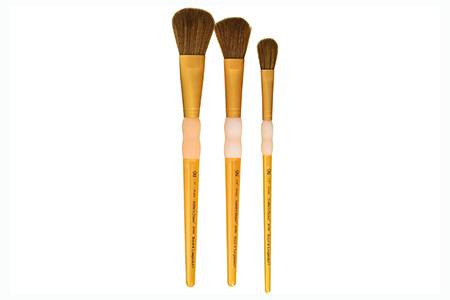
When it comes to coloring up larger areas along with softening the harshest edges, a mop brush seems to be a good choice for artists.
Just like the regular types of mops, this one comes with an almost similar structure. Probably this is why this type of brush is preferred by the artists for the wash.
The bristles are thick, round, and can be of any shape like oval or pointed. This brush is also used for blending, especially with acrylics and oil paints.
Having access to paintings from different angles allows the artist to use them for various projects.
Besides, artists are seen using it to remove excess water from the painting. And yes, twirling the brush on a painting with some colors can create nicer circles.
Egbert Brush
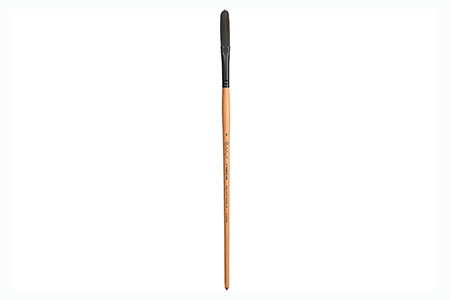
Artists don’t use this brush frequently, and also, it’s not a common one. Like the filbert brush, this one has a chiseled edge with a rounded shape, but the bristles are much longer.
To the Old Masters, this one was among the popular choices. However, it works best with oil-based paint. But for expressive painting, these types of paint brushes work better. So, if you’re asking for a tool that’ll bring you precision, then this one isn’t that.
When a picture demands energy and movement, artists prefer using this one. It’s better to use thin paints instead of thick ones with this brush. But that’ll be of no use if the artist doesn’t have the proper skill with this tool.
Pointed Round Brush
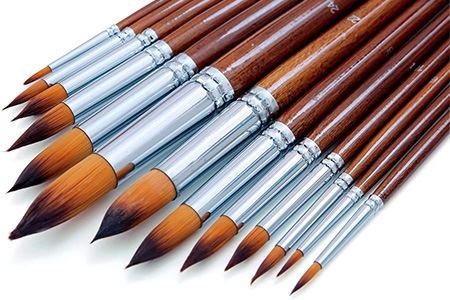
When a painting asks for fine lines and intricate details, a pointed round brush is simply a perfect tool for the job. It comes with a circular tip and handle, similar to a pencil, but tapering down to a perfectly pointed finish.
Rather than being useful in creating a painting, this type of brush is mostly used to touch up finished artworks. Artists use it to ensure precision in their creations.
Besides, it’s used for any kind of addition and alteration to the painting. This brush works best with thinner paints. So, it’s better to avoid the thicker ones.
Wash Brush
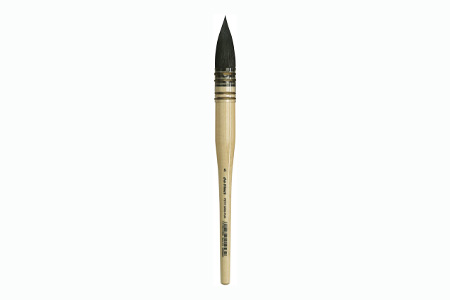
It won’t be wrong if you call it the biggest among all the other paintbrushes out there. After all, it’s made for artworks that require large washes.
The brush is large and has long bristles with a square tip. This brush is compatible with both thick and thin papers. Besides, it covers larger areas at once.
Artists use them for paintings that need large strokes. With the right angle, it’s possible to make thinner lines with it too. The edges it creates are often clean and straight.
Foam Brush
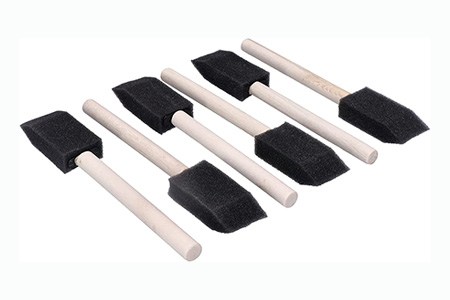
Foam brushes are easy to manage due to their shaped designs. Cutting in edges when painting trim on your walls is very easy with the clean-cut edges provided by these paint brush types.
They're extremely inexpensive so you if you don't want to spend forever trying to wash the paint out of them, it's no big deal. You can use them with paint and stain, but I wouldn't recommend them for polyurethane or other types of seals because of their tendency to introduce air bubbles that have a harder time popping in sealant.
Stencil Brush
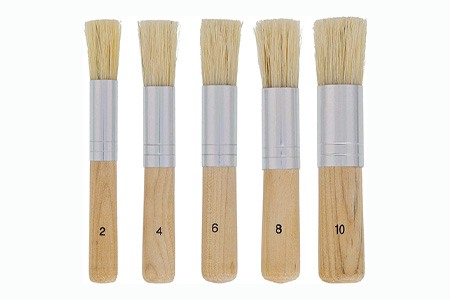
A stencil brush is used for filling in stencils, our favorite of the paint alternatives, whether on your walls, canvas, or any other surface. What makes them different from other types of brushes for painting is that the bristles are very densely packed and then rounded (verses flat).
This helps cover more surface area while dabbing rather than stroking, which is essential to keep paint within the outlines of the stencil rather than it getting too thick and running underneath and out of bounds.
Natural Brush
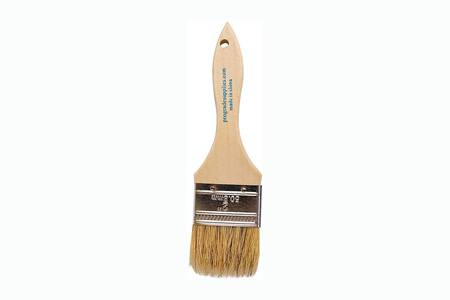
A natural paint brush is one where the bristles are made from real materials, and that means animal hair. Often times this means pig, weasel, mongoose, horse, badger, wolf, camel, goat hair, and hair from other creatures.
The reason people will choose natural types of paint brushes is when they're working with oil paints, varnish, shellac, and other top coats. Not only will the brush hold more paint so you don't have to keep refilling it, but it'll create a smoother final product.
Synthetic Brush
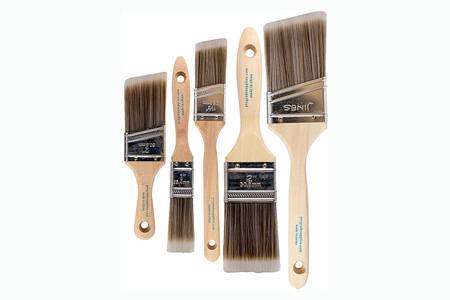
As opposed to natural brushes, synthetic paint brushes have bristles made from either polyester or a nylon and polyester blend. This works much better with water-based paints and acrylic paints like latex paint.
The paint won't cling to the bristles and is more eager to be applied to the surface. Cleaning the bristles afterwards is really easy too, just requiring water and basic types of soap if the paint is still wet. Otherwise isopropyl alcohol can help soften it back up.
Cutting Brush
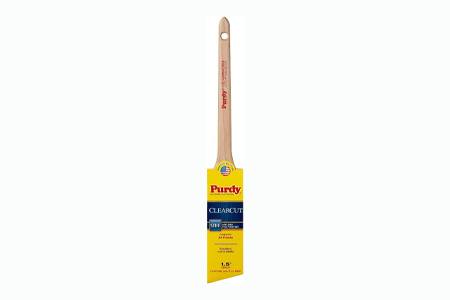
An angle sash brush refers to those with shorter handles and an angled set of bristles. Professionals refer to these as cutting brushes because the straight and angled line of bristles and the short handle makes it much easier to drag straight lines around window frames, door frames, baseboards, and all types of crown molding,
This detail work takes patience and skill, and cutting in around trim with the precision of using any types of pencils has to be done right or you'll have to continually fix errors. The cutting brush makes it a much easier task. It's useful, thanks to the short handle, to paint behind items like toilets, too, which are hard to reach.
Flagged Bristle Paint Brush
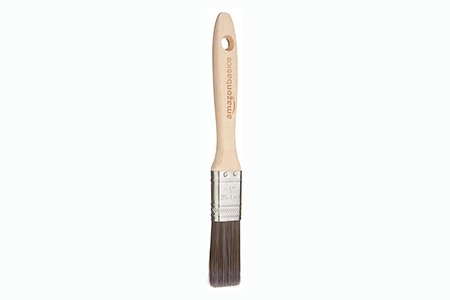
At first glance the flagged bristle paintbrush may not look any different from other different paint brushes, but don't be fooled. The difference lies in the ends of the bristles, which are split in half to double the bristle count and to thin them up.
The result is that you have these paint brush types that can hold more paint in it, which allows you more coverage per load, and it creates a more smooth end result. For those that desire the cleanest, smoothest final product, this is a great choice.
Finishing Brush
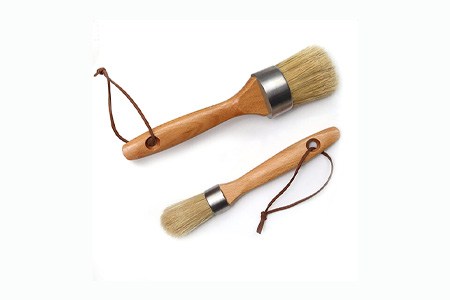
Finish brushes are meant to provide an ultra smooth surface without bubbles, bumps, or streaks. This is achieved by using the softest ox hair bristles when constructing the brush. You'll reach for a finish brush when painting items that get a lot of attention, like railing banisters, any types of deck railings, or the front of your kitchen cabinet doors.
Square Cut Brushes
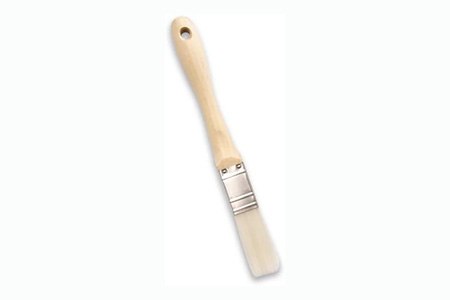
Square cut brushes are extremely wide, way more so than your standard 2 to 3 inch brush. Square cut brushes (called that due to the final shape of the head of the brush looking like a square) will reach up to 4 and 5 inches in width and are perfect types of brushes for painting large surfaces.
The reason this is useful is that there are some surfaces you will paint where you can't use a roller, or it doesn't make sense to, such as sides of bookshelves, types of interior doors with lots of beveled surfaces, and other similar large but not-large-enough surfaces.
Types of Paint Brushes Used for Each DIY Project
It’s true that no tool can make a person an artist, but their creativity does. But when it comes to giving a painting its true form, having the different types of paint brushes on hand becomes more than essential. So, in case you were missing out on any of those, we hope this article has made it easier for you to grab that.



